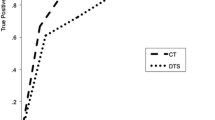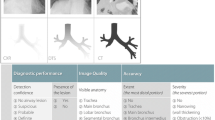Abstract
Thoracic computed tomography (CT) is considered the gold standard for detection lung pathology, yet its efficacy as a screening tool in regards to cost and radiation dose continues to evolve. Chest radiography (CXR) remains a useful and ubiquitous tool for detection and characterization of pulmonary pathology, but reduced sensitivity and specificity compared to CT. This prospective, blinded study compares the sensitivity of digital tomosynthesis (DTS), to that of CT and CXR for the identification and characterization of lung nodules. Ninety-five outpatients received a posteroanterior (PA) and lateral CXR, DTS, and chest CT at one care episode. The CXR and DTS studies were independently interpreted by three thoracic radiologists. The CT studies were used as the gold standard and read by a fourth thoracic radiologist. Nodules were characterized by presence, location, size, and composition. The agreement between observers and the effective radiation dose for each modality was objectively calculated. One hundred forty-five nodules of greatest diameter larger than 4 mm and 215 nodules less than 4 mm were identified by CT. DTS identified significantly more >4 mm nodules than CXR (DTS 32 % vs. CXR 17 %). CXR and DTS showed no significant difference in the ability to identify the smaller nodules or central nodules within 3 cm of the hilum. DTS outperformed CXR in identifying pleural nodules and those nodules located greater than 3 cm from the hilum. Average radiation dose for CXR, DTS, and CT were 0.10, 0.21, and 6.8 mSv, respectively. Thoracic digital tomosynthesis requires significantly less radiation dose than CT and nearly doubles the sensitivity of that of CXR for the identification of lung nodules greater than 4 mm. However, sensitivity and specificity for detection and characterization of lung nodules remains substantially less than CT. The apparent benefits over CXR, low cost, rapid acquisition, and minimal radiation dose of thoracic DTS suggest that it may be a useful procedure. Work-up of a newly diagnosed nodule will likely require CT, given its superior cross-sectional characterization. Further investigation of DTS as a diagnostic, screening, and surveillance tool is warranted.


Similar content being viewed by others
References
Jemal A, Siegel R, Ward E, Murray T, Xu J, Thun MJ: Cancer statistics, 2007. CA: a Cancer Journal for Clinicians 57:43–66, 2007
Henschke CI, McCauley DI, Yankelevitz DF, et al: Early Lung Cancer Action Project: overall design and findings from baseline screening. [see comment]. Lancet 354:99–105, 1999
International Early Lung Cancer Action Program I, Henschke CI, Yankelevitz DF, et al: Survival of patients with stage I lung cancer detected on CT screening. [see comment] [erratum appears in N Engl J Med. 2008 Apr 24;358(17):1862; PMID: 18385492]. New England Journal of Medicine 355:1763–1771, 2006
Aberle DR, Adams AM, Berg CD, et al: Reduced lung-cancer mortality with low-dose computed tomographic screening. New England Journal of Medicine 365:395–409, 2011
Bartholmai BJ, Koo CW, Johnson GB, White DB, Raghunath SM, Rajagopalan S, Moynagh MR, Lindell RM, Hartman TE: Pulmonary nodule characterization, including computer analysis and quantitative features. Journal of Thoracic Imaging 30(2):139–56, 2015
Dobbins 3rd, JT, Godfrey DJ: Digital x-ray tomosynthesis: current state of the art and clinical potential. Physics in Medicine & Biology 48:R65–106, 2003
Vikgren J, Zachrisson S, Svalkvist A, et al: Comparison of chest tomosynthesis and chest radiography for detection of pulmonary nodules: human observer study of clinical cases. Radiology 249:1034–1041, 2008
Svalkvist A, Zachrisson S, Mansson L, Bath M: Investigation of the dosimetry of chest tomosynthesis. Progress in Biomedical Optics and Imaging - Proceedings of SPIE 7258, 2009
Lindell RM, Hartman TE, Swensen SJ, et al: Five-year lung cancer screening experience: CT appearance, growth rate, location, and histologic features of 61 lung cancers.[see comment]. Radiology 242:555–562, 2007
Hart D, Jones D, Wall B: Normalized organ doses for medical X-ray examinations calculated using Monte Carlo Techniques. In: National Radiological Protection Board (NRPB) Report, NRPB-SR 262. HMSO, London, 1994
McCollough C, al. E. The Measurement, Reporting, and Management of Radiation Dose in CT. American Association of Physicists in Medicine 2007; AAPM Report No. 96
MacMahon H, Austin JH, Gamsu G, et al: Guidelines for management of small pulmonary nodules detected on CT scans: a statement from the Fleischner Society.[see comment]. Radiology 237:395–400, 2005
Zhao F, Zeng Y, Peng G, et al: Experimental study of detection of nodules showing ground-glass opacity and radiation dose by using anthropomorphic chest phantom: digital tomosynthesis and multidetector CT. J Comput Assist Tomogr 36:523–7, 2012
Gordic S, Morsbach F: Ultralow-dose chest computed tomography for pulmonary nodule detection: First performance evaluation of single energy scanning with spectral shaping. Invest Radiol 49:465–473, 2014
Author information
Authors and Affiliations
Corresponding author
Rights and permissions
About this article
Cite this article
Langer, S.G., Graner, B.D., Schueler, B.A. et al. Sensitivity of Thoracic Digital Tomosynthesis (DTS) for the Identification of Lung Nodules. J Digit Imaging 29, 141–147 (2016). https://doi.org/10.1007/s10278-015-9818-0
Published:
Issue Date:
DOI: https://doi.org/10.1007/s10278-015-9818-0




